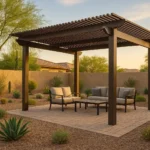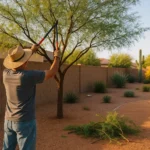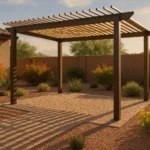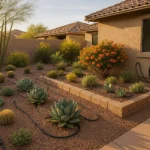Living in Gilbert means embracing outdoor living for much of the year—but also finding clever ways to escape that relentless Arizona sun. With summer temperatures regularly climbing past 110°F, creating effective shade isn’t just about comfort—it’s essential for making your outdoor spaces usable year-round. As someone who’s installed hundreds of shade solutions across the Valley, I’ve learned that the right shade structure can transform an unusable heat trap into your family’s favorite gathering spot.
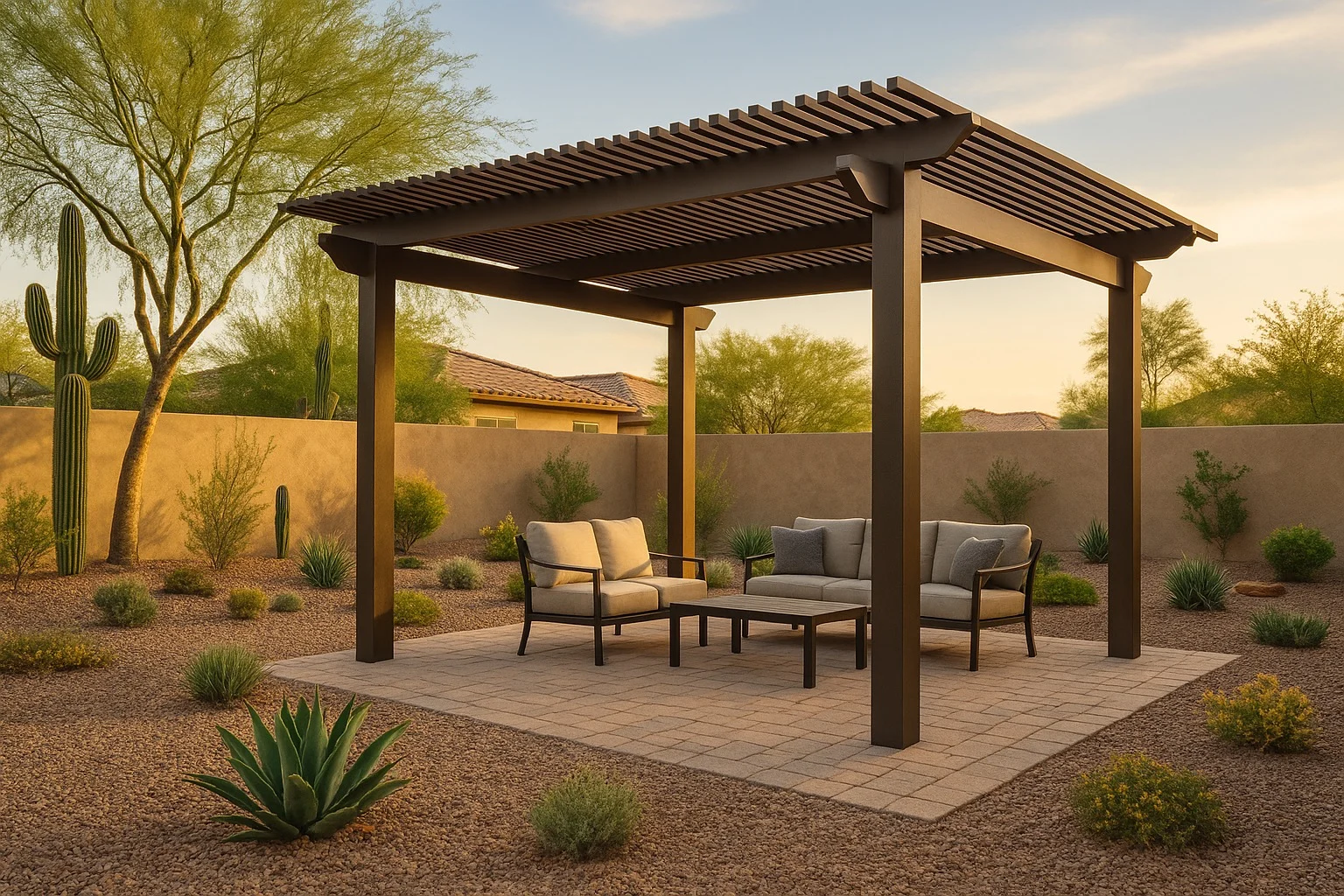
Understanding Gilbert’s Unique Shade Challenges
Gilbert’s desert climate presents specific challenges when planning shade structures. Unlike more temperate regions, we’re not just blocking a bit of afternoon sun—we’re creating livable microclimates in extreme heat. The intensity of our direct sunlight can make a 95°F day feel like 115°F on exposed surfaces. Our low humidity means shade can create a temperature difference of up to 15-20 degrees, making proper placement and design crucial.
The east-west sun trajectory in our region means southern exposures receive the most intense year-round sun, while western exposures face brutal afternoon heat. Many Gilbert neighborhoods feature homes built on north-south streets, creating backyards with challenging western exposure. This orientation demands strategic thinking about permanent versus adjustable shade solutions to maximize comfort as the seasons change.
Local building codes and HOA restrictions also influence shade structure options. Many Gilbert communities have specific height restrictions, setback requirements, and material guidelines that must be considered before installation. Always check with your HOA and the Gilbert Building and Safety Division before starting any permanent shade structure project to avoid costly modifications later.
Permanent Shade Structure Options for Gilbert Homes
Solid patio covers represent the most comprehensive shade solution for Gilbert homeowners seeking maximum heat protection. These permanent structures typically attach to your home’s existing roofline and extend outward, creating a fully shaded living area. For durability in our climate, look for insulated aluminum options that reflect heat rather than absorb it. The latest designs incorporate ceiling fans, recessed lighting, and even misters to further enhance comfort during summer months.
Pergolas offer a more architectural approach while providing adjustable shade. Traditional wooden pergolas add rustic charm but require significant maintenance in our harsh climate. Modern aluminum versions with adjustable louvers give you the flexibility to control sun exposure as needed—fully closed during peak summer and partially open during mild spring and fall days. Many Gilbert homeowners are opting for “smart pergolas” with motorized louvers that can be controlled via smartphone, automatically adjusting based on sun position or temperature readings.
Ramadas, inspired by traditional Southwestern design, offer solid roofing with open sides that encourage airflow while blocking direct sun. These standalone structures work particularly well for creating shade islands in larger Gilbert yards, especially around pool areas or outdoor kitchens where you need protection without attaching to the main house. Materials range from traditional wood with clay tile roofing to modern metal designs with clean lines that complement contemporary Gilbert homes.
Flexible and Temporary Shade Solutions
Shade sails have become increasingly popular in Gilbert neighborhoods for their modern aesthetic and flexibility. These tensioned fabric membranes can be installed in various configurations to block sun throughout the day while adding visual interest to your outdoor space. The best shade sails for our climate use high-density polyethylene (HDPE) fabric with UV stabilizers that resist degradation from our intense sun. Look for options with at least 90% UV blockage and consider overlapping multiple sails for more complete coverage and interesting visual effects.
Retractable awnings provide on-demand shade when you need it and can be retracted during Gilbert’s occasional wind storms or when winter sun is welcome. Modern options include motorized systems with wind sensors that automatically retract in dangerous conditions. While the upfront cost is higher than static options, the flexibility and fabric longevity (not being constantly exposed to the elements) can make them cost-effective over time for east or west-facing patios that receive intense direct sun.
For budget-conscious solutions, consider portable options like umbrella systems, shade canopies, or pop-up gazebos. While not as durable as permanent structures, these can be strategically deployed when needed and stored during monsoon season. Look for commercial-grade umbrellas with wind vents and heavy bases—consumer-grade options rarely last more than a season in our climate. Some Gilbert homeowners use these temporary solutions to “test” shade placements before investing in permanent structures.
Strategic Placement for Maximum Effectiveness
The cardinal rule of shade structure placement in Gilbert is understanding your yard’s sun patterns throughout both the day and the year. Western exposures need afternoon protection during summer but might benefit from winter sun. Southern exposures need year-round coverage but with consideration for winter angles. I recommend tracking sun patterns across your yard for a full day each season before finalizing placement decisions. Simple tools like sun-tracking apps can help visualize how shadows will fall throughout the year.
Consider prevailing wind patterns when designing your shade structure. Gilbert often experiences easterly morning breezes and afternoon winds from the southwest during monsoon season. Solid walls or structures that block these natural cooling breezes can create stagnant hot spots. Conversely, structures that channel breezes can enhance cooling effects. The ideal design often incorporates solid coverage overhead with strategic openings to promote air circulation.
Don’t overlook the heat radiating from surrounding hardscapes. Concrete patios, pool decks, and block walls absorb heat throughout the day and release it slowly, creating what feels like an oven effect even after sunset. Effective shade strategies address not just direct sun but also this radiant heat. Consider extending shade structures to cover adjacent hardscapes or incorporating cooling elements like misters or fans to counteract this effect.
Material Considerations for Gilbert’s Climate
Material selection can make or break a shade structure’s effectiveness in our extreme climate. Metal structures without proper insulation can become heat conductors, actually increasing temperatures underneath. Wood, while aesthetically pleasing, requires significant maintenance to prevent warping, cracking, and color fading. Composite materials offer durability but can be costly. For most applications, I recommend powder-coated aluminum with proper insulation for the optimal balance of durability, heat resistance, and maintenance requirements.
Fabric elements require special consideration in Gilbert. Standard acrylic awning fabrics typically last 5-8 years before UV degradation becomes severe. HDPE shade sail fabrics generally offer 8-12 years of life with proper tensioning and occasional cleaning. The color of your shade fabric significantly impacts its cooling effectiveness—lighter colors reflect more heat but show dirt more readily, while darker colors provide better UV protection but absorb more heat. For most Gilbert installations, I recommend mid-tone neutrals like sand, taupe, or sage that balance heat reflection with practical maintenance.
Roofing and covering materials for solid structures should prioritize reflectivity and insulation. Standing seam metal roofing with reflective coatings can reduce heat transfer by up to 70% compared to conventional materials. For attached structures, matching your home’s existing roofing creates a cohesive look but may not provide optimal heat resistance. Consider adding an insulation layer beneath whatever roofing material you choose to further reduce heat transfer and prevent your shade structure from becoming a heat trap.
Integrating Cooling Systems with Shade Structures
Combining shade structures with active cooling systems multiplies their effectiveness in Gilbert’s extreme heat. Ceiling fans installed on covered patios create air movement that can make the space feel 4-8 degrees cooler. For optimal performance, choose outdoor-rated fans with at least 52″ blade spans and variable speed controls. Position them 8-9 feet above the ground and centered over seating areas rather than cooking spaces where they might interfere with grills.
Misting systems have evolved significantly from the high-pressure systems that once left everything damp. Modern flash-evaporation systems use specialized nozzles and precise water pressure to create micro-droplets that evaporate before reaching surfaces. These systems can lower the ambient temperature by 10-20 degrees in our dry climate. For permanent installations, consider recessed misters integrated into your shade structure’s perimeter rather than add-on systems that can detract from aesthetics.
For the ultimate outdoor comfort, some Gilbert homeowners are investing in outdoor air conditioning units designed specifically for covered patios. These specialized systems are designed to cool defined outdoor areas without the energy waste of trying to condition completely open spaces. While the initial investment is significant (typically $4,000-$8,000 installed), they can make outdoor living comfortable even during the hottest July afternoons. These systems work best with shade structures that have at least partial walls or drop screens to contain the cooled air.
Budget-Friendly Shade Strategies
Creating effective shade doesn’t always require massive investment. Strategic planting of desert-adapted trees can provide significant shade within 3-5 years. Desert-adapted options like Palo Verde, Texas Ebony, or Chinese Pistache offer excellent canopies while requiring minimal irrigation once established. Position these future shade trees on the south and west sides of your outdoor living areas for maximum benefit. While waiting for trees to mature, temporary shade solutions can bridge the gap.
DIY shade sail installations can significantly reduce costs if you’re comfortable with basic construction. Pre-made shade sails typically cost $50-$300 depending on size and quality, while professional installation might add $500-$1,500. By installing your own heavy-duty mounting points and tensioning the sails yourself, you can create effective shade at a fraction of professional installation costs. Just be sure to use appropriate concrete footings for posts and heavy-duty mounting hardware rated for wind loads.
Phased implementation allows you to spread costs over time while learning what works best for your specific yard. Start with smaller, targeted shade in the most-used areas, then expand as budget allows. Many Gilbert homeowners begin with a small covered section directly off the house, then add pergolas, shade sails, or extended roofing in subsequent years. This approach also lets you adjust your strategy based on how you actually use the space rather than trying to predict everything in advance.
Shade Structure Maintenance in Gilbert’s Climate
Our intense sun, occasional monsoon winds, and dust storms create unique maintenance challenges for shade structures. Establish a regular inspection routine—check tension on shade sails before and after monsoon season, examine fasteners and connection points for signs of stress or corrosion, and look for fabric deterioration like thinning or color fading. Small issues addressed promptly prevent costly failures during extreme weather events.
Dust accumulation is inevitable in our desert environment and can significantly reduce the reflectivity and effectiveness of shade materials over time. For fabric elements, gentle cleaning with mild soap and water twice yearly helps maintain performance and extend lifespan. For solid roofing, consider an annual professional cleaning that includes checking for and sealing any developing gaps or cracks where heat could penetrate.
Plan for periodic replacement of fabric elements. Even the highest quality materials will eventually succumb to our intense UV exposure. Budget for shade sail replacement every 8-10 years and awning fabric replacement every 6-8 years. When selecting your initial installation, consider systems with easily replaceable components rather than designs requiring complete reconstruction when elements fail.
Quick Shade Structure Checklist for Gilbert Homeowners
Before finalizing your shade structure plans, run through this essential checklist to ensure you’ve covered all the critical considerations for our unique climate:
- ✓ Confirm HOA and city permit requirements for your specific structure
- ✓ Map sun patterns across all seasons, not just summer extremes
- ✓ Consider prevailing wind directions to enhance natural cooling
- ✓ Select materials rated for 110°F+ temperatures and high UV exposure
- ✓ Ensure proper drainage for monsoon downpours
- ✓ Plan for adequate structural support to withstand occasional high winds
- ✓ Incorporate supplemental cooling if the space will be used during peak summer
- ✓ Consider nighttime lighting needs within your shade design
- ✓ Plan for future expansion or modifications as your needs change
- ✓ Establish a maintenance schedule appropriate for your selected materials
With thoughtful planning and strategic implementation, your Gilbert outdoor space can become a comfortable retreat even during the most challenging desert conditions. The right shade structure doesn’t just block sun—it creates an outdoor living environment that your family will enjoy year-round, adding both functionality and value to your home. By understanding the unique challenges of our climate and addressing them proactively, you’ll create shade solutions that truly enhance your Gilbert lifestyle.

